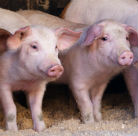What Diet Energy Density Should I Be Feeding to My Grow-Finish Pigs?
Posted: March 10, 2015 | Written By: Simon Kern, M.S., Form-A-Feed Nutritional Services

Several methods for balancing growing and finishing diets for digestible amino acids, minerals, and vitamins exist today. However, the energy density of these balanced diets can vary greatly.
This will largely be determined by the inclusion rate of by-product feed ingredients (dried distillers’ grains, wheat middlings, etc.) and whether or not an added fat source (choice white grease, corn oil, etc.) is included. Customers often ask what energy density they should feed. The answer is really quite simple: it depends.
While there is certainly a sliding scale to diet energy density, diets usually fall into one of three classes: low, moderate, or high energy. The gross cost per ton of finished feed typically follows the same pattern with greater energy correlating to increased cost. Low energy diets typically contain an elevated level of by-product feed ingredients which tend to cost less than conventional ingredients. By-product feeds can be utilized to provide essential nutrients and reduce diet cost per ton of complete feed. For example, a moderate level of distillers’ grains will replace a portion of the corn, soybean meal, and phosphorus in grow-finish diets. On the other hand, high energy diets are primarily corn and soybean meal based and will contain added fat. Including feed additives such as Liberate can also increase diet energy through the use of enzymes which release additional energy from feed ingredients. Feeding high energy diets will result in a greater cost per ton of complete feed.
So why would a producer want to feed high energy diets if they come at an added cost? High energy density diets have several advantages when compared to low energy density diets. Grow-finish pigs will tend to consume a quantity of feed to reach a set amount of energy intake, thus the lower the energy density, the more feed pigs will consume. Low energy diets will increase average daily feed intake while subsequently reducing average daily gain. The net result is poorer feed conversion rates. The increased feed intakes associated with low energy density diets will also increase the pig’s gut mass resulting in decreased carcass yield.
Pigs consuming a high energy diet need less time at the feeder to meet their caloric needs. Less crowding at the feeder will reduce live weight variability across a pen resulting in more full-value pigs. High energy diets will also increase average daily gain and improve feed efficiency. The net result is pigs reach market weight in fewer days or heavier market pigs in a set number of days when compared topigs consuming low energy diets.
With all these advantages the question then becomes: why wouldn’t a producer feed high energy diets? The answer: sometimes these advantages are not enough to pay for the added diet cost. This largely depends on market conditions (ingredient prices, lean hog futures, etc.) and your unique production situation. Your Form-A-Feed swine representative can help you answer this question to maximize your profitability per pig. Inquire about a current Results Driven Solutions profit analysis today. Learn more about our Swine Services here.
Reference:
Beaulieu, A. D., N. H. Williams, and J. F. Patience. 2009. Response to dietary digestible energy concentrations in growing pigs fed cereal grain-based diets. J. Anim. Sci. 87:965-976.